
There are several reasons why someone might want to buy an antique pocket watch. For some, it is the beauty and craftsmanship of the watch itself that is appealing. Antique pocket watches can be works of art, with intricate engravings and delicate designs. For others, it is the history and nostalgia associated with antique pocket watches that is appealing. These watches often have a story to tell, and owning one can be a way of preserving a piece of history. Additionally, antique pocket watches can be valuable collectables, and some people enjoy the challenge of building a collection of rare and unique watches. In this article, we will uncover the secrets of antique pocket watches, from their types and value, to where to find them and how to care for them. Let’s get started.
Introduction to Antique Pocket Watches
The history of antique pocket watches is more closely tied to the history of timekeeping. The first pocket watch was invented by Peter Henlein in 1510 (16th Century) in Nuremberg, Germany, Pocket watches were a significant advancement over earlier timekeeping devices such as sundials and hourglasses. These early pocket watches were often highly ornate and decorated, reflecting the status and wealth of their owners.
As timekeeping technology improved, pocket watches became more accurate and reliable. By the 18th and 19th centuries, pocket watches were an essential part of everyday life, and were widely used by both men and women. They were often carried in a pocket or attached to a chain, and could be easily consulted to check the time.
The invention of the wristwatch in the early 20th century led to a decline in the popularity of pocket watches, but they remained in use for many years. Today, antique pocket watches are prized by collectors for their beauty, craftsmanship, and historical significance.
Mechanical Types of Antique Pocket Watches
There are many different types of antique pocket watches to look for, each with their own unique features and designs. Some of the main mechanical types of antique pocket watches include:
1. Fusee Movement Pocket Watches

Fusee pocket watches: These were some of the first types of pocket watches to be developed and were popular from the 16th to the 19th centuries. They used a system of weights and pulleys to maintain a constant power supply to the watch movement, which helped improve timekeeping accuracy.
2. Lever Set Pocket Watches

Lever-set pocket watches: Lever-set pocket watches were developed in the early 19th century and were a major improvement over the fusee design. They used a lever system to set the time, making it much easier and more convenient than earlier designs.
3. Key Wind Pocket Watches
Key-wind pocket watches: Key-wind pocket watches were popular in the 18th and 19th centuries, and as the name suggests, they were wound using a small key. These watches were often highly decorative and were a popular choice for wealthy individuals.
4. Repeater Pocket watches
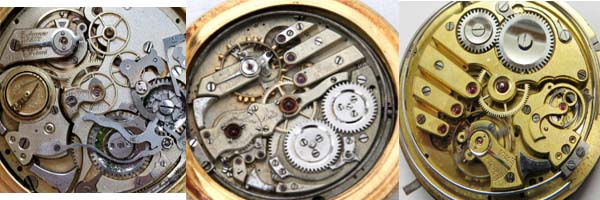
Repeater pocket watches: Repeater pocket watches were developed in the late 17th century and featured a mechanism that allowed the wearer to chime the time on demand. This was done by pressing a button or sliding a lever, which activated a series of bells or gongs to chime the hour and sometimes the minute.
Understanding The Various Design Types Of Antique Pocket Watches
- Open-faced Pocket Watch – A open-face pocket watch is a type of pocket watch that does not have a protective cover or bezel over the face of the watch. These watches were common were more prone to damage because of their lack of protection.
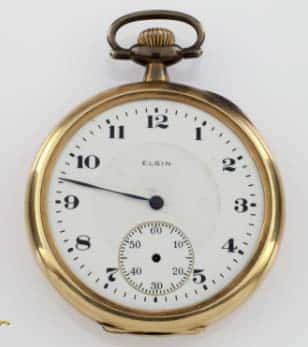
- Half-Hunter Pocket Watch – A pocket watch with a protective cover or bezel over the face of the watch with a small window to read the time without having to open the watch.
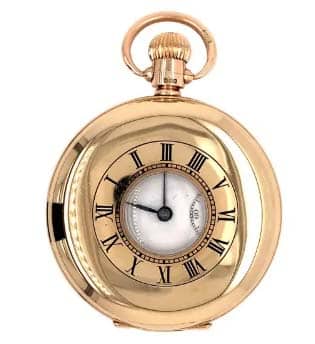
- Full-Hunter Pocket Watch – A type of pocket watch with a protective cover or bezel over the face of the watch. The protective cover on the face of the watch made it more difficult to read the time but also protected the watch from damage. To read the time you would have to open the cover to see the watch’s face.
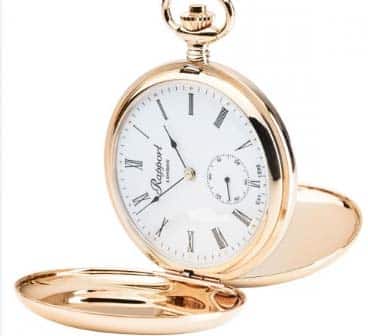
- Double Half Hunter Pocket Watch – A type of pocket watch with two protective covers or bezels, one over the face of the watch (with a small window to view the time without opening the cover) and one over the back.
- Double Hunter Pocket Watch – A type of pocket watch with two protective covers or bezels, one over the face of the watch and one over the back.
The Different Metals Used for Antique Pocket Watches
One of the most important aspects of antique pocket watches is the type of metal they are made of. The most common metals used for pocket watches are gold, enamel, silver, brass, and steel.
Gold (22ct, 18ct, 9ct)
An antique gold pocket watch is a type of timepiece that was made with a gold case and a small, enamel watch face. Gold pocket watches were very popular during the 19th and early 20th centuries, and they were often made by some of the most prestigious watchmakers of the time. Gold pocket watches were typically made with either a solid gold case or a gold-plated case, and they were often decorated with intricate engravings or enamel designs. These watches were considered to be a symbol of luxury and status, and they were often given as gifts to mark special occasions or as a reward for outstanding achievement. Today, antique gold pocket watches are highly sought after by collectors,
Enamelled (Gold/Silver)
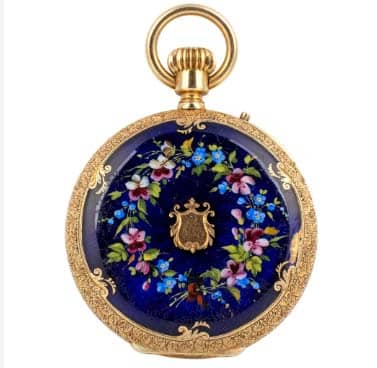
Enamel pocket watches are often decorated with intricate designs or patterns, which are created by applying different colors of enamel to the watch face. These designs can be applied using a variety of techniques, such as hand-painting, stenciling, or using a process known as “champlevé” enameling, where the enamel is applied to grooves or indentations in the metal surface of the watch. Some of the most common decorative motifs on enamel pocket watches include floral designs, landscapes, and geometric patterns. These watches are considered to be highly collectible, and they can be quite valuable depending on their age, condition, and level of craftsmanship.
Solid Silver
An antique solid silver pocket watch is a type of timepiece that was made with a solid silver case and a small, enamel watch face. Silver pocket watches were very popular during the 19th and early 20th centuries, and they were often made by some of the most prestigious watchmakers of the time. Silver pocket watches were typically made with a solid silver case, and they were often decorated with intricate engravings or enamel designs. These watches were considered to be a symbol of luxury and status.
Brass & Steel
Brass and steel pocket watches are usually the least expensive type of pocket watch. They are usually less ornate and detailed than gold or silver pocket watches, but they can still be very beautiful.
How to Recognize a Rare Antique Pocket Watch
When it comes to recognizing a rare antique pocket watch, there are several key factors to consider. For starters, you should look for pocket watches made of rare or exotic materials, such as gold, silver or enamel as these fetch higher prices. There are several ways to recognize an antique pocket watch and we have listed some basic guidelines of what to look out for when you come across an antique pocket timepiece:
- Check the age: One of the most obvious ways to determine if a pocket watch is antique is to check its age. Most antique pocket watches were made before the 20th century, so if the watch in question was made after 1900, it is likely not an antique.
- Look for hallmarks: Many antique pocket watches will have hallmarks stamped on the case or movement, which can help to identify the maker and date of the watch. These hallmarks may include a maker’s mark, a hallmark indicating the metal content of the case, and a date letter indicating the year the watch was made.
- Examine the movement: Antique pocket watches often had unique and intricate movements, which can help to identify the watch as an antique. Look for complex mechanisms, such as fusee systems, lever-set mechanisms, and repeater mechanisms, which were commonly used in antique pocket watches.
- Consider the design: Antique pocket watches often had distinct and recognizable designs, which can help to identify them as such. Look for decorative features, such as enamel work, engravings, and filigree, which were commonly found on antique pocket watches.
- Research the maker: If you are unsure whether a pocket watch is antique, you can try researching the maker to determine when the company was in operation. This can help to narrow down the time period in which the watch was made and give you a better idea of its age.
Value of Antique Pocket Watches
The value of antique pocket watches can vary greatly, depending on their age, condition, and rarity. Generally speaking, antique pocket watches that are made of solid gold or silver are the most valuable, but even pocket watches made of brass or steel can be valuable depending on there age, maker and condition.
When it comes to determining the value, it’s important to take into account its condition. If the pocket watch has been well maintained and in good condition, it will be worth more than one in poor condition. It’s also important to consider the age of the pocket watch, as older pocket watches tend to be more valuable than newer ones.
If you manage to come across a 17th or 18th-century pocket watch by one of Britain’s famous horological names such as George Graham and Thomas Mudge they could be worth a small fortune.
Where to Find Rare Antique Pocket Watches
When it comes to finding rare antique pocket watches, there are several places to look. One of the best places to start is at antique stores, as they often have a wide selection of pocket watches for sale. You can also look online, as there are many online stores that specialize in antique pocket watches.
If you’re looking for even rarer antique pocket watches, you can try looking at vintage markets and auctions. These events often have rare and unique pocket watches for sale, and you may be able to find one that is not available anywhere else.
Finally, if you’re looking for an even rarer antique pocket watch, you can try searching for it on specialized forums and websites. These forums and websites are often full of collectors who are looking to buy or sell rare pocket watches, and they can be a great way to find a rare and valuable pocket watch.
Popular Antique Pocket Watchmaker Brands That Sell Well
If you struggle to find a rare 17th or 18th-century pocket watch, check out some of the more recent 19th-century watchmaker brands that collectors love. Some of the top brands are listed below:
1. Audemars Piguet
Audemars Piguet is a Swiss luxury watch manufacturer that was founded in 1875.
2. J W Benson
J W Benson is a British watch company that was founded in 1847
3. Elgin
Elgin is an American watch company that was founded in 1864.
4. Longines
Longines is a Swiss luxury watch company that was founded in 1832
5. Patek Philippe
Patek Philippe is a Swiss luxury watch company that was founded in 1839
Top Tips for Buying an Antique Pocket Watch
When looking at an antique pocket watch, there are several things you should check to determine its age, authenticity, and condition. Never buy without first checking through the list below to ensure you get what you pay for. Damage to an antique pocket watch can in some cases render them worthless. So to make sure you do your due diligence check out the following tips:
- Age: One of the first things to check when looking at an antique pocket watch is its age. Most antique pocket watches were made before the 20th century, so if the watch in question was made after 1900, it is likely not an antique.
- Hallmarks: Many antique pocket watches will have hallmarks stamped on the case or movement, which can help to identify the maker and date of the watch. These hallmarks may include a maker’s mark, a hallmark indicating the metal content of the case, and a date letter indicating the year the watch was made.
- Movement: Antique pocket watches often had unique and intricate movements, which can help to identify the watch as an antique. Look for complex mechanisms, such as fusee systems, lever-set mechanisms, and repeater mechanisms, which were commonly used in antique pocket watches.
- Design: Antique pocket watches often had distinct and recognizable designs, which can help to identify them as such. Look for decorative features, such as enamel work, engravings, and filigree, which were commonly found on antique pocket watches.
- Condition: Finally, it is important to carefully inspect the overall condition of the antique pocket watch. Look for signs of wear and tear, damage, or repair, which can affect the value and authenticity of the watch. If possible, have the watch examined by a professional to determine its condition.
Conclusion
Antique pocket watches are timeless classics that have been around for centuries. From pocket watches made of solid gold, to pocket watches made of silver and brass, these rare treasures have been sought after by collectors for many decades. In this blog article, we uncovered the secrets of antique pocket watches, from their types and value, to where to find them and how to care for them.
Whether you’re looking for a rare antique pocket watch, or just want to add a piece of history to your collection, plenty of options are available. From antique stores and online stores, to vintage markets and specialized forums, there are plenty of places to find rare and unique pocket watches. And don’t forget to visit Antiques Store Bournemouth for the best selection of vintage and antique pocket watches.
